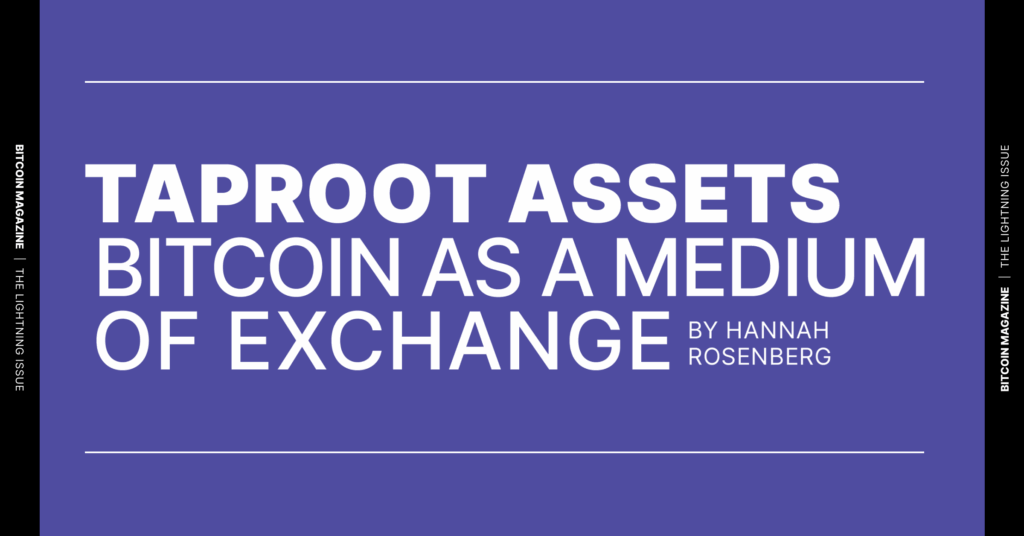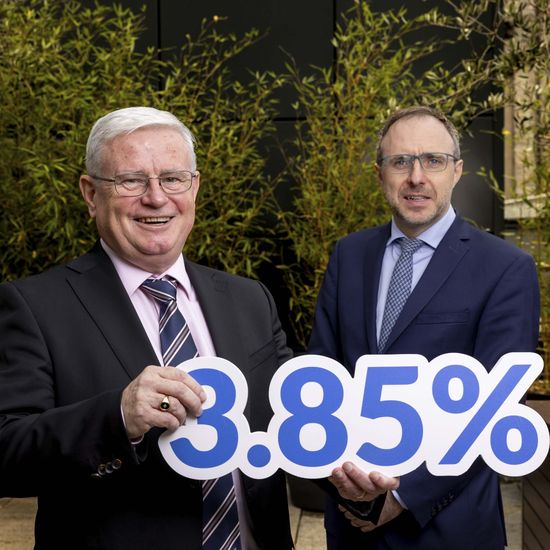Copyright Bitcoin Magazine

What is Bitcoin and who is it for? There are a plethora of catchphrases available on Twitter to cover this one. Bitcoin is for everyone… no wait, it’s for anyone! Bitcoin is a store of value. Bitcoin is a medium of exchange. We could do a classic appeal to authority and declare that Bitcoin is exactly what Satoshi described, “A Peer-to-Peer Electronic Cash System”. Bitcoin becomes what we make it. It serves the people we choose to build for. If we want Bitcoin to be a store of value or medium of exchange, we have to build the protocols and services that make this happen. Sometimes it’s more interesting to ask specifically, who are we building for? Are we building for Americans looking for a long-term investment? Are we building for a shop owner in Brazil? A reseller in Turkey? A software developer in Nigeria? If we want bitcoin to be a medium of exchange, we need to focus on the users who need it most — and Taproot Assets is the tool for that job. Taproot Assets Taproot Assets allows us to take the assets, and units of account, that people want and need today as mediums of exchange — and move them to Bitcoin infrastructure on the Lightning Network. From a technical perspective, Taproot Assets is a protocol that allows for the minting of assets on the Bitcoin blockchain in a very blockspace-efficient fashion using taproot transactions, made possible by the November 2021 Taproot soft fork activation. Client-side validation is used, the protocol is opt-in, and no consensus changes are required. Fungible assets are exchangeable on the Lightning Network, and you can use this protocol on mainnet today! Taproot Assets is a flexible protocol that’s already opening the door to a wide variety of use cases, but the core use case is stablecoins on Lightning. For those wanting to learn more, here are the docs, and tutorial and demo videos can be found here. So, why is this such a powerful tool for adoption? Meet People Where They Are It’s easy to get immersed in the Bitcoin world — where we use bitcoin, talk about it constantly, and dive deep into all the things it fixes. That passion and curiosity is powerful. But the real magic happens when we connect that world to people outside it. Most people don’t have the time available to study monetary theory or economic history. Free time and disposable income are not the norm in the world. Stay humble. If we want Bitcoin to serve the world, let’s meet people where they are. And we can: We have the tools and the skills to build things that are truly useful — products that people love not because they’re Bitcoin-powered, but because they solve real problems. Adoption won’t come just from our impressive understanding of Austrian economics, it will come from building things that are so useful people can’t help using them. The true measure is in the utility. The true measure is in the users. Number of people go up! Stablecoins And so let’s talk about stablecoins. Love them or question them, stablecoins have clearly found product-market fit. The invisible hand has spoken! Let’s look at some numbers: In Brazil, approximately 90% of crypto transactions are tied to stablecoins, primarily for payments and remittances. Tether estimates it has 434 million users worldwide, transacting $31 billion USDT daily. About 13% of the total USDT supply is held by savers who are likely emerging markets users without other access to dollars. Tether (USDT) has a market cap of $153 billion and recorded over $10 trillion in total volume in 2024. USD Coin (USDC) follows with a $61 billion market cap. (Numbers from CoinGecko at time of writing.) Utility Why have the people chosen stablecoins? Utility. Most people around the world don’t have the luxury to HODL through a bear market. Most humans don’t ponder the intricacies of fractional reserve banking. They’re busy living — busy being fathers, and mothers, and small business owners, and doctors, and carpenters, and farmers, teachers, and students. All the things that keep the world turning. Most people are simply seeking an improvement in their day-to-day lives, and it’s our job, as experts on money, to give them what they need. They need stability and affordability. Infrastructure Adoption As the Bitcoin adoption story goes, first we achieve store of value, then medium of exchange, and then unit of account — the final boss! But if we facilitate stablecoins, are we preventing bitcoin from achieving unit of account? No. Bitcoin will be a unit of account if and when the world needs it to, if and when we make it available. Those choosing to use a stablecoin on the Lightning Network will be doing so because it is the best option for them; it’s the option that brings the most utility. They aren’t thinking about “adopting Bitcoin”, and they don’t intend to adopt bitcoin, the unit of account. But they will be adopting Bitcoin, the network. They will be adopting Bitcoin, the payments infrastructure. We often think of replacing the Visa network and to do that we have to be more useful than Visa, which processes transactions in 175 different currencies. Our Turkish reseller is an expert in what he does, and not an expert on decentralized networking technology. He’ll choose Lightning over Visa when it becomes the better, more affordable, easier option for running his business. And for many businesses, Lightning already is the faster, more affordable option. Let’s imagine that precoiner shop owner in Brazil. She’s managing her business making transactions using a stablecoin via a Taproot Assets Lightning wallet. She’s made the switch to Bitcoin infrastructure. She was enticed to do so by a simple, easy-to-use mobile wallet that simplified her business, cut her costs, and reduced her risk. This wallet allows her to make instantly settled, global, incredibly affordable transactions, and to do so in a wide variety of currencies. She came for the utility of this medium of exchange, but is now one button away from losing her precoiner status. And, should that global fiat money collapse finally arrive one random Tuesday afternoon, she just needs to push that button to switch out of fiat and into sats because she is already running on Bitcoin infrastructure. A Multi-Asset Network The potential and utility of a Taproot Assets-enabled, multi-asset Lightning Network is grossly underappreciated. Seriously: It’s a medium of exchange like the world has never seen before. Application builders and their users can have any unit of account that they like — U.S. dollars, Brazilian reais, euros, etc. — and it’s all routed through Bitcoin. Taproot Assets Lightning transactions require Bitcoin liquidity. These transactions support and grow the Lightning Network and enable a plethora of options. A payment can be sent out by Alice in USD, but Bob can receive BTC. Alice can send another payment in USD that will be routed through the Lightning Network, through the sats-denominated liquidity in the center of the Lightning Network, on to Carol who opts to receive a euro-denominated stablecoin. Our Turkish reseller can sell goods to our Brazilian shop owner using a stablecoin. Not only can he interact with businesses around the world without friction, but also any regular Bitcoiner can transact with either using sats, seamlessly. No need to touch that stablecoin if they don’t want to. And it gets even cooler. Let’s imagine for a moment this scenario… (https://x.com/MichaelLevin/status/1885402488955662448) A global, scalable, instantly settled payment network that’s meaningfully cheaper than Visa — a payment network that now gives users the option to transact in whatever coin they prefer. This is the brilliance of building with Bitcoin as infrastructure — people adopt the network before they even know it’s Bitcoin. Conclusion If we want to see Bitcoin as a medium of exchange, if this is what we are building for, it’s our job as the experts to give the people what they are clearly telling us that they need: instant, low-fee, stable-value transactions. In other words, multi-asset Lightning. Now, of course Taproot Assets is a versatile protocol. It can and will be used for all sorts of things — including use cases that appeal to the American crowd who see bitcoin primarily as a long-term investment. Yay, permissionless innovation! With this protocol, we’re helping usher Bitcoin in its medium of exchange era.



